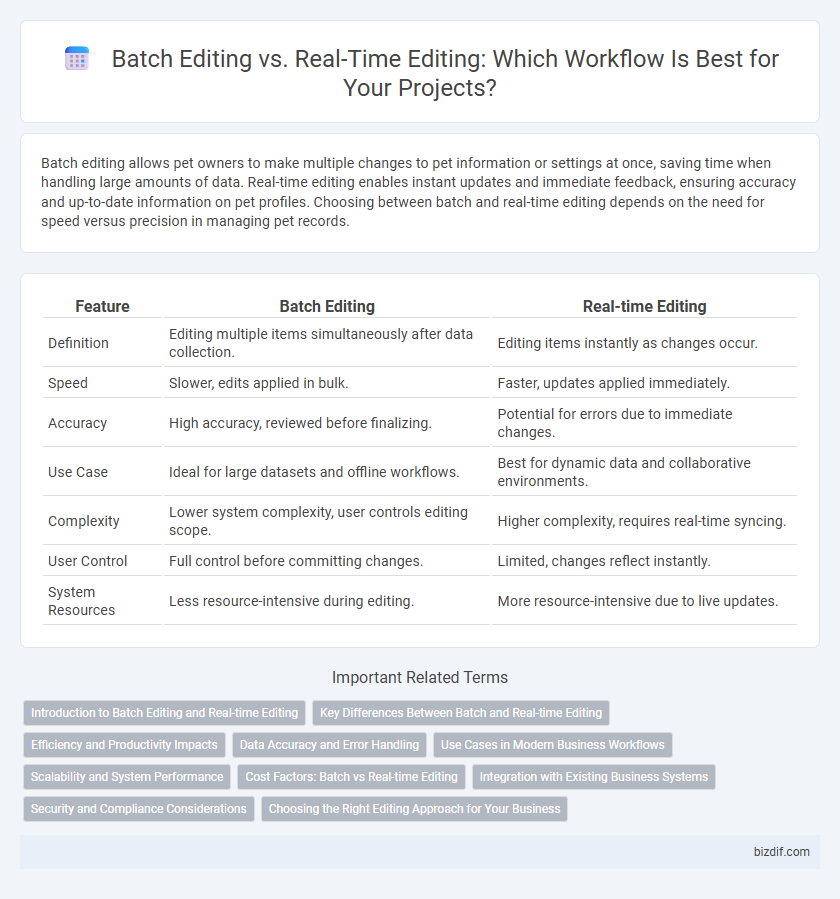Batch editing allows pet owners to make multiple changes to pet information or settings at once, saving time when handling large amounts of data. Real-time editing enables instant updates and immediate feedback, ensuring accuracy and up-to-date information on pet profiles. Choosing between batch and real-time editing depends on the need for speed versus precision in managing pet records.
Table of Comparison
| Feature | Batch Editing | Real-time Editing |
|---|---|---|
| Definition | Editing multiple items simultaneously after data collection. | Editing items instantly as changes occur. |
| Speed | Slower, edits applied in bulk. | Faster, updates applied immediately. |
| Accuracy | High accuracy, reviewed before finalizing. | Potential for errors due to immediate changes. |
| Use Case | Ideal for large datasets and offline workflows. | Best for dynamic data and collaborative environments. |
| Complexity | Lower system complexity, user controls editing scope. | Higher complexity, requires real-time syncing. |
| User Control | Full control before committing changes. | Limited, changes reflect instantly. |
| System Resources | Less resource-intensive during editing. | More resource-intensive due to live updates. |
Introduction to Batch Editing and Real-time Editing
Batch editing processes multiple media files simultaneously, optimizing workflow efficiency by applying uniform changes across large datasets. Real-time editing enables immediate modifications and instant previews, crucial for dynamic content requiring rapid adjustments and quick decision-making. Understanding these editing modes helps creators choose between bulk processing and interactive, on-the-fly refinement based on project demands.
Key Differences Between Batch and Real-time Editing
Batch editing processes multiple files or changes simultaneously, optimizing workflow for large-scale adjustments with minimal immediate feedback, while real-time editing enables instant modifications and immediate preview, crucial for dynamic content creation and live collaboration. Batch editing excels in environments demanding efficiency and consistency across extensive datasets, whereas real-time editing prioritizes responsiveness and adaptability, supporting rapid iteration and on-the-fly corrections. Key differences also include resource demands, with batch editing often requiring higher computational power for processing, contrasted by real-time editing's need for low latency and seamless user experience.
Efficiency and Productivity Impacts
Batch editing processes multiple files or data sets simultaneously, significantly reducing the repetitive manual effort and enhancing overall workflow efficiency. Real-time editing enables instant updates and immediate feedback, which accelerates decision-making and minimizes delays in collaborative environments. Choosing between batch and real-time editing depends on the specific productivity goals, with batch editing suited for large-scale adjustments and real-time editing optimized for dynamic, continuous improvements.
Data Accuracy and Error Handling
Batch editing processes large datasets at once, which can lead to delayed error detection but allows thorough validation, improving overall data accuracy through comprehensive review. Real-time editing offers immediate error identification and correction, enhancing data accuracy by preventing mistakes from propagating but may miss complex inconsistencies detectable only through batch analysis. Effective error handling in batch editing relies on post-processing validation scripts, while real-time editing integrates automated checks and instant feedback to maintain high data quality continuously.
Use Cases in Modern Business Workflows
Batch editing excels in scenarios requiring bulk processing of large data sets, such as updating product catalogs or performing mass corrections in document repositories, where efficiency and consistency are paramount. Real-time editing is ideal for collaborative environments like live content creation, customer support, and dynamic marketing campaigns, enabling immediate updates and responsive decision-making. Modern business workflows often integrate both approaches to balance accuracy and agility, optimizing productivity across diverse operational needs.
Scalability and System Performance
Batch editing excels in scalability by processing large volumes of data simultaneously, reducing system load and optimizing resource allocation for extensive projects. Real-time editing demands more from system performance, requiring low latency and instantaneous updates, which can strain processing power and bandwidth during collaborative or high-frequency editing scenarios. Choosing between batch and real-time editing depends on the scale of the workload and the need for immediate feedback, balancing efficiency and responsiveness for optimal system management.
Cost Factors: Batch vs Real-time Editing
Batch editing reduces costs by allowing multiple files to be processed simultaneously, minimizing manual labor and time expenditure. Real-time editing incurs higher expenses due to the need for immediate processing power, advanced software, and continuous monitoring to ensure instant updates. Budget considerations often favor batch editing for large volumes of content, while real-time editing suits projects requiring instant accuracy and responsiveness despite its higher cost.
Integration with Existing Business Systems
Batch editing allows seamless integration with existing business systems by processing large volumes of data simultaneously, minimizing disruption to workflows and ensuring compatibility with established databases and content management tools. Real-time editing supports dynamic updates and immediate synchronization across platforms, enabling more responsive content management but requiring robust API connections and advanced system interoperability. Choosing between batch and real-time editing depends on the organization's infrastructure capacity and the need for immediate data reflection within its business processes.
Security and Compliance Considerations
Batch editing processes data in controlled intervals, reducing exposure to security vulnerabilities by limiting the number of system access points at any given time, which helps maintain compliance with data protection regulations such as GDPR and HIPAA. Real-time editing demands robust encryption protocols and continuous monitoring to prevent unauthorized access while enabling immediate data updates, posing challenges for meeting strict compliance standards. Organizations must evaluate their security infrastructure to balance the risks of real-time editing against the safer, albeit slower, batch editing method for regulatory adherence.
Choosing the Right Editing Approach for Your Business
Batch editing processes large volumes of content simultaneously, ideal for businesses with extensive datasets or projects requiring consistency and speed. Real-time editing offers immediate updates and collaboration, perfect for companies prioritizing agility and dynamic content changes. Selecting the right editing approach depends on factors like project scale, turnaround time, and the need for collaborative flexibility in your workflow.
Batch Editing vs Real-time Editing Infographic

 bizdif.com
bizdif.com